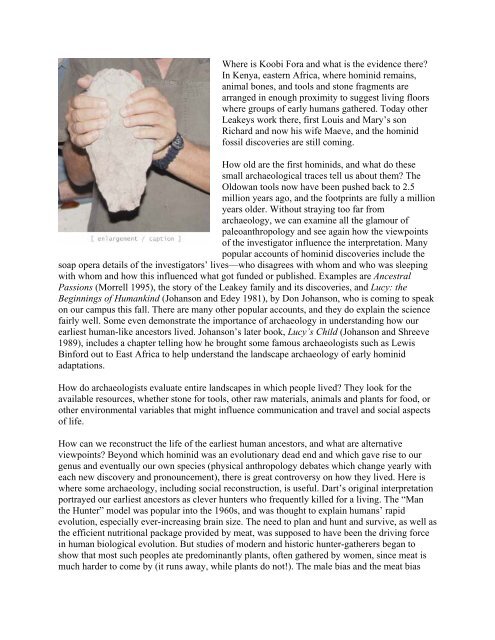INTRODUCTION TO ARCHAEOLOGY Nancy White - Touro Institute
INTRODUCTION TO ARCHAEOLOGY Nancy White - Touro Institute
INTRODUCTION TO ARCHAEOLOGY Nancy White - Touro Institute
Create successful ePaper yourself
Turn your PDF publications into a flip-book with our unique Google optimized e-Paper software.
Where is Koobi Fora and what is the evidence there?<br />
In Kenya, eastern Africa, where hominid remains,<br />
animal bones, and tools and stone fragments are<br />
arranged in enough proximity to suggest living floors<br />
where groups of early humans gathered. Today other<br />
Leakeys work there, first Louis and Mary’s son<br />
Richard and now his wife Maeve, and the hominid<br />
fossil discoveries are still coming.<br />
How old are the first hominids, and what do these<br />
small archaeological traces tell us about them? The<br />
Oldowan tools now have been pushed back to 2.5<br />
million years ago, and the footprints are fully a million<br />
years older. Without straying too far from<br />
archaeology, we can examine all the glamour of<br />
paleoanthropology and see again how the viewpoints<br />
of the investigator influence the interpretation. Many<br />
popular accounts of hominid discoveries include the<br />
soap opera details of the investigators’ lives—who disagrees with whom and who was sleeping<br />
with whom and how this influenced what got funded or published. Examples are Ancestral<br />
Passions (Morrell 1995), the story of the Leakey family and its discoveries, and Lucy: the<br />
Beginnings of Humankind (Johanson and Edey 1981), by Don Johanson, who is coming to speak<br />
on our campus this fall. There are many other popular accounts, and they do explain the science<br />
fairly well. Some even demonstrate the importance of archaeology in understanding how our<br />
earliest human-like ancestors lived. Johanson’s later book, Lucy’s Child (Johanson and Shreeve<br />
1989), includes a chapter telling how he brought some famous archaeologists such as Lewis<br />
Binford out to East Africa to help understand the landscape archaeology of early hominid<br />
adaptations.<br />
How do archaeologists evaluate entire landscapes in which people lived? They look for the<br />
available resources, whether stone for tools, other raw materials, animals and plants for food, or<br />
other environmental variables that might influence communication and travel and social aspects<br />
of life.<br />
How can we reconstruct the life of the earliest human ancestors, and what are alternative<br />
viewpoints? Beyond which hominid was an evolutionary dead end and which gave rise to our<br />
genus and eventually our own species (physical anthropology debates which change yearly with<br />
each new discovery and pronouncement), there is great controversy on how they lived. Here is<br />
where some archaeology, including social reconstruction, is useful. Dart’s original interpretation<br />
portrayed our earliest ancestors as clever hunters who frequently killed for a living. The “Man<br />
the Hunter” model was popular into the 1960s, and was thought to explain humans’ rapid<br />
evolution, especially ever-increasing brain size. The need to plan and hunt and survive, as well as<br />
the efficient nutritional package provided by meat, was supposed to have been the driving force<br />
in human biological evolution. But studies of modern and historic hunter-gatherers began to<br />
show that most such peoples ate predominantly plants, often gathered by women, since meat is<br />
much harder to come by (it runs away, while plants do not!). The male bias and the meat bias
















